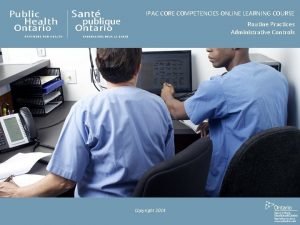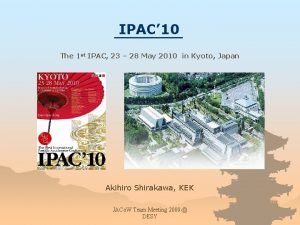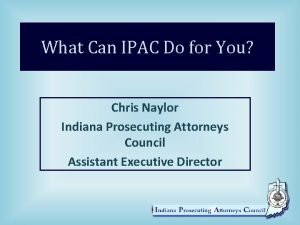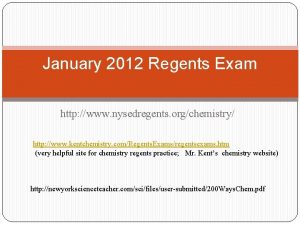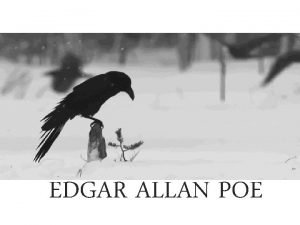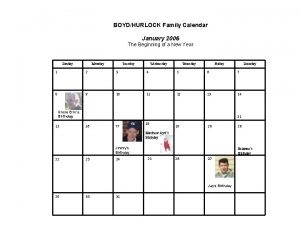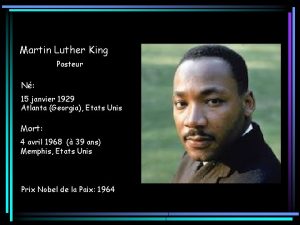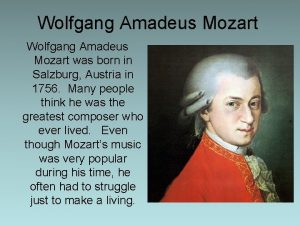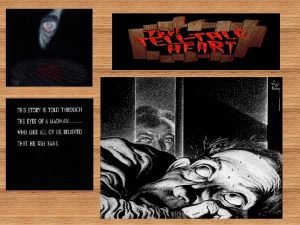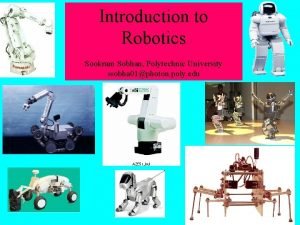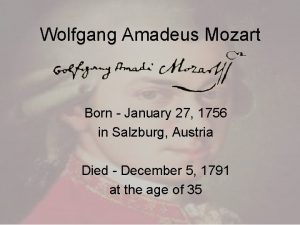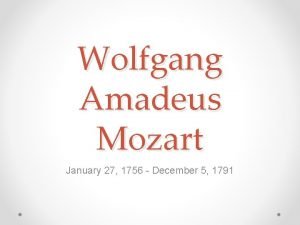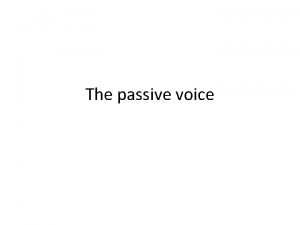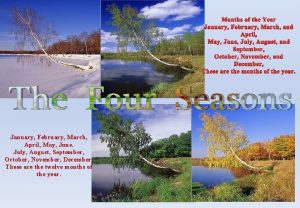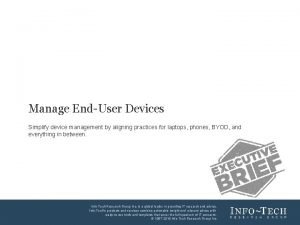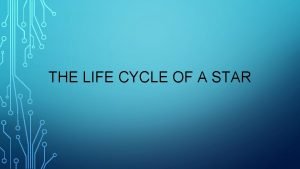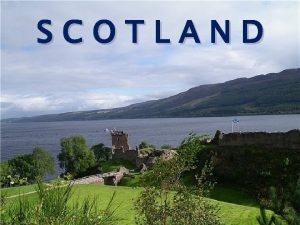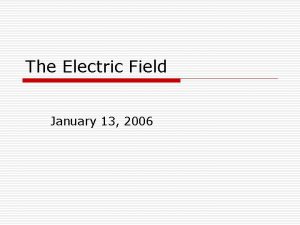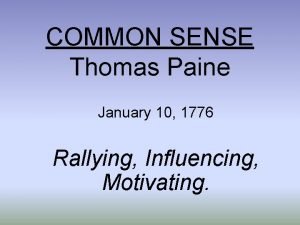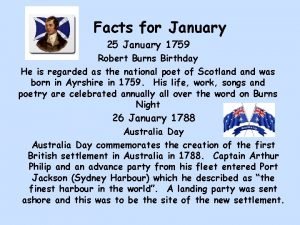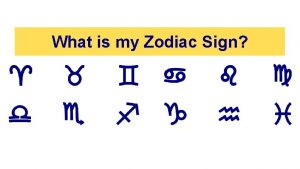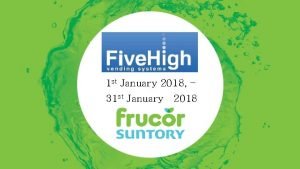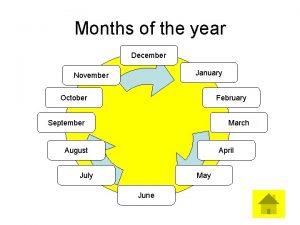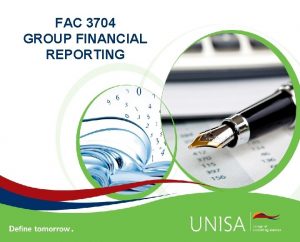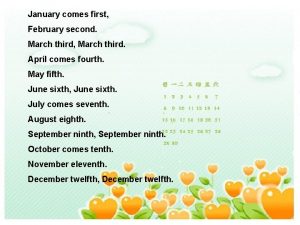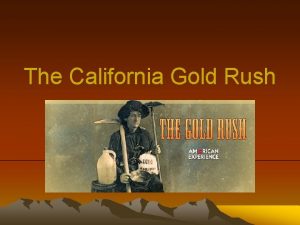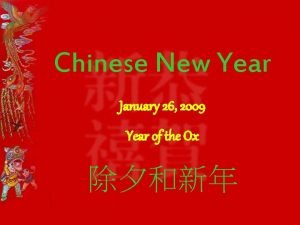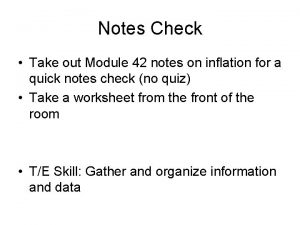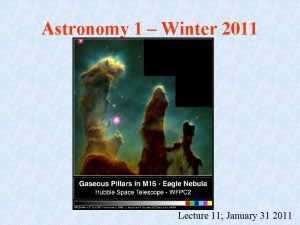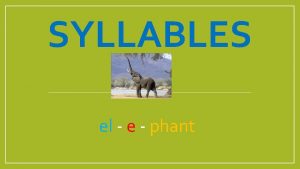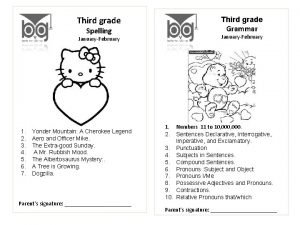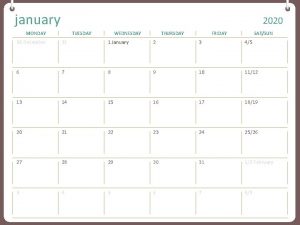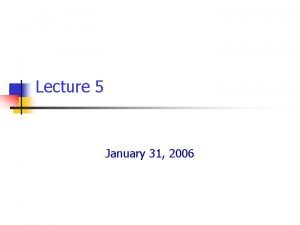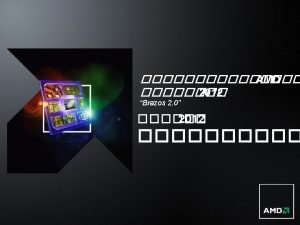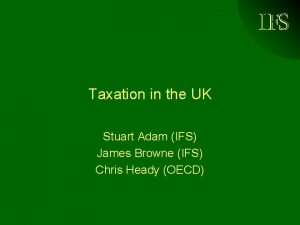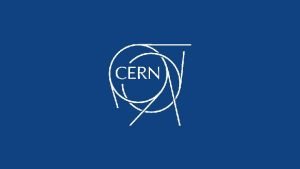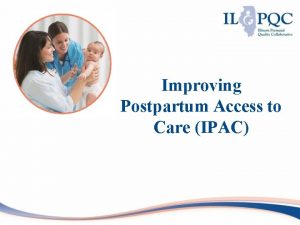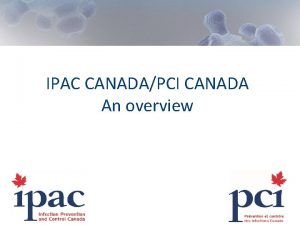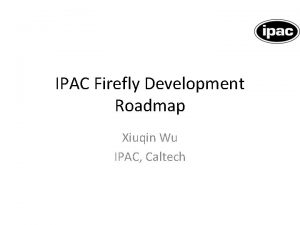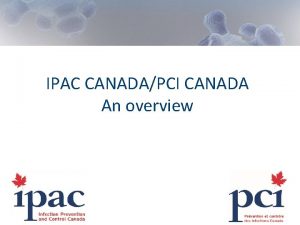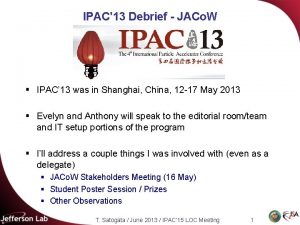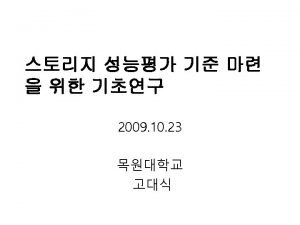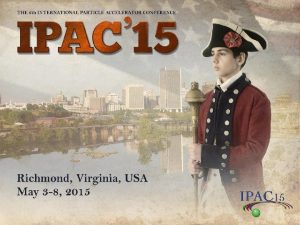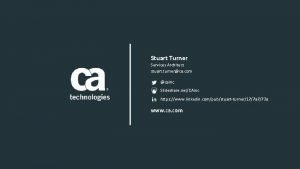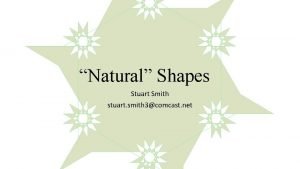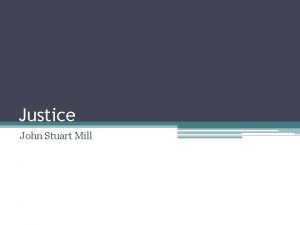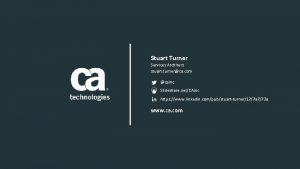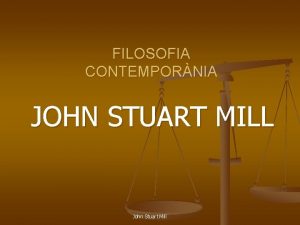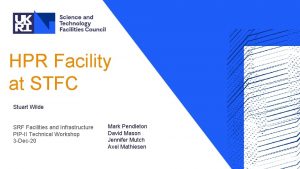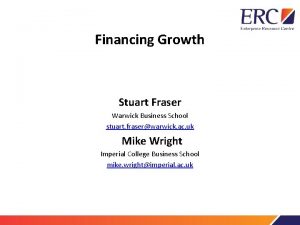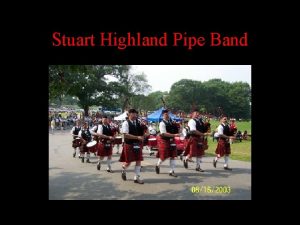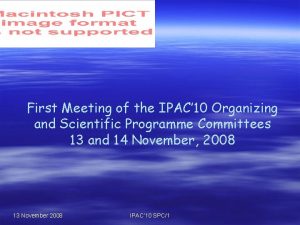IPAC 15 SPC1 Meeting January 8 2014 Stuart

























































- Slides: 57

IPAC 15 SPC/1 Meeting January 8, 2014 Stuart Henderson IPAC 15 SPC Chair

2 S. Henderson, SPC/1, Jan. 8, 2014

3 S. Henderson, SPC/1, Jan. 8, 2014

4 S. Henderson, SPC/1, Jan. 8, 2014

Scientific Secretariat Todd Satogata With support from Erin Clifton 5 S. Henderson, SPC/1, Jan. 8, 2014

SPC/1 Agenda 1. 2. 3. Welcome and Approval of the Agenda (S. Henderson) Introduction of SPC Members Composition of the SPC, Description of Tasks, Overview of Timeline, Meetings Schedule, Deadlines and Procedures (S. Henderson) Proposals for the Composition of the Scientific Advisory Board 4. Coffee Break 5. 6. 7. De‐brief of the Scientific Programme of IPAC’ 13 (Q. Qin) Report on the Status of the Scientific Programme of IPAC’ 14 (G. Arduini) Review of Main Classifications and Scopes 9. 10. 11. 6 • • 09: 20 – 09: 50 – 10: 35 – 10: 50 Lunch Break 8. 09: 00 – 09: 10 – 09: 20 10: 50 – 11: 20 – 11: 40 – 12: 10 – 13: 30 Program structure and outline of IPAC’ 15 13: 30 – 14: 30 Discussion on IPAC’ 15 program elements, including 14: 30 – 15: 30 Any Other Business Tour of Conference Venue with OC 15: 30 – 16: 00 – 17: 00 Development of overview of IPAC’ 15 proposed program Number of parallel sessions, allotment by main classification. Synoptic Table Draft Opening/closing plenary sessions, Industry session, Special Sessions Prize session, Student poster session, etc. S. Henderson, SPC/1, Jan. 8, 2014

Scientific Program Committee 7 S. Henderson, SPC/1, Jan. 8, 2014

SPC Composition 8 S. Henderson, SPC/1, Jan. 8, 2014

Roles and Responsibilities • IPAC 15 Organizing Committee – Overall responsibility for the conference, its organization, finances, etc. • IPAC 15 Scientific Program Committee – A subcommittee of the Organizing Committee – Responsible for the Scientific Program, selection of Oral program, layout of the program • IPAC 15 Scientific Advisory Board – Provides advice to the SPC regarding the invited oral program 9 S. Henderson, SPC/1, Jan. 8, 2014

SPC Tasks – SPC/1 Meeting • Select members of the Scientific Advisory Board • Review and finalize Main Classifications and Sub‐classifications • Allocate Sessions amongst the Main Classifications • Establish the Program structure and organization • Produce draft synoptic table 10 S. Henderson, SPC/1, Jan. 8, 2014

SPC/2 Meeting (1 year before IPAC 15) • Select Invited Orals from those proposed via SPMS by SPC/SAB/OC • Select Opening/Closing Plenary Speakers/Topics • Select Industry Session speakers • Finalize Special Session speakers • Select Session Chairs 11 S. Henderson, SPC/1, Jan. 8, 2014

SPC/3 Meeting (4‐ 5 months before IPAC 15) • Select contributed orals (and e‐Posters? ) from submitted abstracts • Finalize any outstanding Program issues 12 S. Henderson, SPC/1, Jan. 8, 2014

Scientific Program Timeline (Proposed) • Jan. 8, 2014: SPC/1 Meeting – Richmond, VA • May 12, 2014: Proposal deadline for invited oral suggestions from OC/SAB/SPC members • SPC/2 Meeting – Propose to hold at IPAC 14 (Dresden, Germany) – Invited Oral Program selection • December 3, 2014: Abstract submission deadline • SPC/3 Meeting: January 20, 2015 in Vancouver (? ) – select contributed orals 13 S. Henderson, SPC/1, Jan. 8, 2014

Scientific Advisory Board 14 S. Henderson, SPC/1, Jan. 8, 2014

Scientific Advisory Board • The role of the SAB is to propose invited oral presentations and speakers and provide feedback after the conference • The SAB includes – 40 members from the host region (Americas) – 25 members from each of the other regions (Asia and Europe) • Guidelines: – – – 15 Prominent scientists Coverage of all fields of accelerator science and technology Balance institutions, countries Strive to include new members, look out for diversity Does not include present members of SPC or OC S. Henderson, SPC/1, Jan. 8, 2014

Proposed SAB Composition ‐ Asia 16 S. Henderson, SPC/1, Jan. 8, 2014

Proposed SAB Composition ‐ Europe 17 S. Henderson, SPC/1, Jan. 8, 2014

Proposed SAB Composition ‐ Americas 18 S. Henderson, SPC/1, Jan. 8, 2014

Americas: By Expertise/Institution 19 S. Henderson, SPC/1, Jan. 8, 2014

Main Classifications 20 S. Henderson, SPC/1, Jan. 8, 2014

Main Classifications IPAC 12, IPAC 13 and IPAC 14 have used the same Main Classifications: • 01 Circular and Linear Colliders • 02 Synchrotron Light Sources and FELs • 03 Particle Sources and Alternative Acceleration Techniques • 04 Hadron Accelerators • 05 Beam Dynamics and EM Fields • 06 Beam Instrumentation, Controls, Feedback and Operational Aspects • 07 Accelerator Technology Main Systems • 08 Applications of Accelerators, Tech Transfer and Industrial Relations 21 S. Henderson, SPC/1, Jan. 8, 2014

Sub‐classifications • • • • • • • • • 22 01 Opening Presentation 02 Closing Presentation 03 Special Presentation 04 Prize Presentation A 01 Hadron Colliders A 02 Lepton Colliders A 03 Linear Colliders A 04 Circular Accelerators A 05 Synchrotron Radiation Facilities A 06 Free Electron Lasers A 07 Electrostatic Accelerators A 08 Linear Accelerators A 09 Muon Accelerators and Neutrino Factories A 10 Damping Rings A 11 Beam Cooling A 12 FFAG A 13 Cyclotrons A 14 Neutron Spallation Facilities A 15 New Acceleration Techniques A 16 Advanced Concepts A 17 High Intensity Accelerators A 18 Energy Recovery Linacs A 19 Electron Hadron Colliders A 20 Radioactive Ions A 21 Secondary Beams A 22 Plasma Wakefield Acceleration A 23 Accelerators and Storage Rings, Other D 01 Beam Optics ‐ Lattices, Correction Schemes, Transport D 02 Non‐linear Dynamics ‐ Resonances, Tracking, Higher Order D 03 High Intensity in Circular Machines D 04 High Intensity in Linear Accelerators D 05 Instabilities ‐ Processes, Impedances, Countermeasures D 06 Code Developments and Simulation Techniques • • • • • • • • • T 01 Proton and Ion Sources T 02 Electron Sources T 03 Beam Diagnostics and Instrumentation T 04 Accelerator/Storage Ring Control Systems T 05 Beam Feedback Systems T 06 Room Temperature RF T 07 Superconducting RF T 08 RF Power Sources T 09 Room‐temperature Magnets T 10 Superconducting Magnets T 11 Power Supplies T 12 Beam Injection/Extraction and Transport T 13 Cryogenics T 14 Vacuum Technology T 15 Undulators and Wigglers T 16 Pulsed Power Technology T 17 Alignment and Survey T 18 Radiation Monitoring and Safety T 19 Collimation T 20 Targetry T 21 Infrastructures T 22 Reliability, Operability T 23 Machine Protection T 24 Timing and Synchronization T 25 Lasers T 26 Photon Beam Lines and Components T 27 Low Level RF T 28 Neutron Sources T 29 Technology Transfer T 30 Industrial Collaboration T 31 Subsystems, Technology and Components, Other U 01 Medical Applications U 02 Materials Analysis and Modification U 03 Transmutation and Energy Production U 04 Security U 05 Other Applications S. Henderson, SPC/1, Jan. 8, 2014

Main Classification 01 ‐ Circular and Linear Colliders Classification 1 is devoted to synchrotrons and storage rings providing colliding beams for particle physics experiments, essentially lepton and hadron colliders in operation, under construction or under development. It includes facilities colliding beams from circular accelerators with beams from other types of accelerators, such as linac‐ring colliders. Among the subjects for this classification are operating experience and performance limitations, upgrade plans, accelerator physics and technology issues specific to a certain collider and the design and R&D for future projects. Sub‐classifications associated with MC 01 are: • A 01 Hadron Colliders • A 02 Lepton Colliders • A 03 Linear Colliders A 08 Linear Accelerators • A 09 Muon Accelerators and Neutrino Factories • A 10 Damping Rings • A 12 FFAG • A 16 Advanced Concepts • A 17 High Intensity Accelerators • A 18 Energy Recovery Linacs (ERLs) • A 19 Electron‐Hadron Colliders • A 23 Accelerators and Storage Rings, Other • T 12 Beam Injection/Extraction and Transport • T 19 Collimation 23 S. Henderson, SPC/1, Jan. 8, 2014

Main Classification 02 – Synchrotron Light Sources and FELs Classification 2 covers Light Sources based on synchrotron storage rings and linacs including Energy Recovery Linacs (ERLs) and FELs. These light sources incorporate advanced insertion devices, including high quality planar and helical field undulators based on permanent magnet or electromagnet technologies. Associated accelerator systems, such as injectors, booster synchrotrons, photon beam line and photon beam line components can also be proposed for this Session, as can laser systems and their use. Papers presented can be project descriptions or cover individual aspects of light sources. Both theoretical and experimental results are solicited. Sub‐classifications associated with MC 02 are: • A 05 Synchrotron Radiation Facilities • A 06 Free Electron Lasers • A 16 Advanced Concepts • A 18 Energy Recovery Linacs (ERLs) • T 02 Electron Sources • T 12 Beam Injection/Extraction and Transport • T 15 Undulators and Wigglers • T 25 Lasers • T 26 Photon Beam Lines and Components Shall we broaden this classification in recognition of growing interest in THz, Compton source and related developments? 24 S. Henderson, SPC/1, Jan. 8, 2014

Main Classification 03 – Particle Sources and Alternative Acceleration Techniques Classification 3 is devoted to (i) all aspects of the design and development of particle sources, including sources of electrons and protons, neutrons, ions, and secondary particles and antiparticles; and (ii) to new concepts of accelerating techniques which may overcome the present limitations due to size and cost of future large accelerators or give access to very new beam characteristics Sub‐classifications associated with MC 03 are: • A 09 Muon Accelerators and Neutrino Factories • A 12 FFAG • A 15 New Acceleration Techniques • A 16 Advanced Concepts • A 17 High Intensity Accelerators • A 20 Radioactive Ions • A 21 Secondary Beams • A 22 Plasma Wakefield Acceleration • D 04 High Intensity in Linear Accelerators ‐ Incoherent Instabilities, Space Charge, Halos, Cooling • T 01 Proton and Ion Sources • T 02 Electron Sources • T 28 Neutron Sources 25 S. Henderson, SPC/1, Jan. 8, 2014

Main Classification 04 – Hadron Accelerators Classification 4 is devoted to designing, developing, upgrading, constructing and commissioning low‐, medium‐ and high‐energy hadron accelerators, excluding hadron colliders. The session includes ion sources, electrostatic accelerators, proton and ion linear accelerators, proton and ion synchrotrons, radioactive beam facilities, antiproton accumulators and collectors, ion accumulator and storage rings, cyclotrons, synchrocyclotrons, FFAGs and any other similar machines. Both low‐ and high‐intensity machines are covered, as are all relevant aspects of high‐intensity fixed‐target machines such as proton drivers for spallation neutron sources, neutrino factories, etc. Sub‐classifications associated with MC 04 are: • A 04 Circular Accelerators • A 07 Electrostatic Accelerators • A 08 Linear Accelerators • A 11 Beam Cooling • A 12 FFAG • A 13 Cyclotrons • A 14 Neutron Spallation Facilities • A 16 Advanced Concepts • A 17 High Intensity Accelerators • A 21 Secondary Beams • T 01 Proton and Ion Sources • T 12 Beam Injection/Extraction and Transport • T 19 Collimation • T 28 Neutron Sources 26 S. Henderson, SPC/1, Jan. 8, 2014

Main Classification 05 – Beam Dynamics and EM Fields Classification 5 includes reviews and progress reports on general aspects of electro‐ magnetic interaction of charged particle beams in accelerators and storage rings. It covers linear and non‐linear beam optics, modeling of externally applied or beam‐ generated electro‐magnetic fields, as well as theory, observations and simulations of single‐particle dynamics and collective effects, both coherent and incoherent. The emphasis is on deepening the understanding of fundamental processes or limitations governing beam dynamics and uncovering possible new mechanisms relevant to accelerator design and performance, independent of technological or project‐specific aspects. Sub‐classifications associated with MC 05 are: • D 01 Beam Optics – Lattices, Correction Schemes, Transport • D 02 Non‐linear Dynamics – Resonances, Tracking, Higher Order • D 03 High Intensity in Circular Machines – Incoherent Instabilities, Space Charge, Halos, Cooling • D 04 High Intensity in Linear Accelerators – Incoherent Instabilities, Space Charge, Halos, Cooling D 05 Instabilities – Processes, Impedances, Countermeasures • D 06 Code Developments and Simulation Techniques 27 S. Henderson, SPC/1, Jan. 8, 2014

Main Classification 06 – Beam Instrumentation, Controls, Feedback and Operational Aspects Classification 6 is devoted to measurement and control of the beam parameters in particle accelerators including beam diagnostics and instrumentation, beam feedback systems, timing and synchronization schemes and laser‐based instrumentation. Included also are contributions on accelerator/storage ring control systems and operational aspects of modern accelerators such as alignment and surveying methods, machine protection systems, and issues pertaining to reliability and operability and to radiation monitoring and safety. Sub‐classifications associated with MC 06 are: • T 03 Beam Diagnostics and Instrumentation • T 04 Accelerator/Storage Ring Control Systems • T 05 Beam Feedback Systems • T 17 Alignment and Survey • T 18 Radiation Monitoring and Safety • T 22 Reliability, Operability • T 23 Machine Protection • T 24 Timing and Synchronization • T 25 Lasers • T 26 Photon Beam Lines and Components 28 S. Henderson, SPC/1, Jan. 8, 2014

Main Classification 07 – Accelerator Technology Main Systems Classification 7 is devoted to contributions on the design, construction, testing and performance of accelerator components or subsystems, with emphasis on technological aspects and methods. Special attention is due to technological developments that allow to improve accelerators from the point of view of performance, size or cost effectiveness. Sub‐classifications associated with MC 07 are : • T 06 Room Temperature RF • T 07 Superconducting RF • T 08 RF Power Sources • T 09 Room Temperature Magnets • T 10 Superconducting Magnets • T 11 Power Supplies • T 13 Cryogenics • T 14 Vacuum Technology • T 16 Pulsed Power Technology • T 19 Collimation • T 20 Targetry • T 21 Infrastructures • T 23 Machine Protection • T 24 Timing and Synchronization • T 25 Lasers • T 27 Low Level RF • T 31 Subsystems, Technology and Components, Other 29 S. Henderson, SPC/1, Jan. 8, 2014

Main Classification 08 – Applications of Accelerators, Technology Transfer and Industrial Relations • Scope of Applications: Classification 8 includes contributions with emphasis on applications of accelerators rather than on accelerator aspects proper. • Scope of Technology Transfer: The Technology Transfer Session, is mainly addressed to Accelerator Laboratories to improve the methods and strategies for TT, and to Industry to create business out of TT. It covers relevant issues for successful TT, structures needed to promote TT, technology incubator for start‐‐‐up companies, and intellectual property and patenting. • Scope of Session on Relations with Industry: The Session on Relations between Laboratories and Industry is addressed to both sides in order to improve performance and the achievement of the contract goals through the creation of mutual understanding, contractual matters, joint research and development, measures to improve contract goals. 30 S. Henderson, SPC/1, Jan. 8, 2014

Distribution of Oral/Posters by Main Classification From SPMS, thanks Todd! 31 S. Henderson, SPC/1, Jan. 8, 2014

Distribution of Oral/Posters by Main Classification 32 S. Henderson, SPC/1, Jan. 8, 2014

Distribution of Oral/Posters by Main Classification 33 S. Henderson, SPC/1, Jan. 8, 2014

Distribution by Region 34 S. Henderson, SPC/1, Jan. 8, 2014

Distribution by Region 35 S. Henderson, SPC/1, Jan. 8, 2014

Distribution by Region 36 S. Henderson, SPC/1, Jan. 8, 2014

Discussion on Main Classifications • Synchrotron Radiation Sources and FELs, Photon Sources? • Where does CEBAF fit in, and electron linacs generally? 37 S. Henderson, SPC/1, Jan. 8, 2014

Program Structure 38 S. Henderson, SPC/1, Jan. 8, 2014

IPAC 12 Special Session for Industry 39 S. Henderson, SPC/1, Jan. 8, 2014

IPAC 13 Special Session for Industry 40 S. Henderson, SPC/1, Jan. 8, 2014

IPAC 14 41 S. Henderson, SPC/1, Jan. 8, 2014

Oral Program Statistics 42 S. Henderson, SPC/1, Jan. 8, 2014

IPAC 15 Program Proposal for Discussion 43 S. Henderson, SPC/1, Jan. 8, 2014

Presentations, timing, etc. • Tradition has – 30 minutes (25 presentation + 5 min questions) for Invited Oral – 20 minutes (17 presentation + 3 min questions) for Contributed Oral • This allows – 90 min session: 1 invited + 3 contributed – 120 min session: 2 invited + 3 contributed, 6 contributed, 4 invited, etc. • Keep parallel session formats the same so that there are common start/stop times 44 S. Henderson, SPC/1, Jan. 8, 2014

Proposal for Discussion • Adopt the general layout of IPAC 12 – Two Invited Oral sessions in the AM – Three Contributed Oral sessions in the PM Monday‐Wednesday • Make minor adjustments to time allotments to better reflect contribution volume • Otherwise, keep the structure the same 45 S. Henderson, SPC/1, Jan. 8, 2014

Rationale • Balance between competing desires: – Desire to increase invited session time, and oral presentation time generally, which is increasingly important given travel support problems in US – Desire to give invited sessions appropriate stature and focus favoring 2 parallel sessions – Anticipate attendance of ~1200, which is large for the two‐ session format (in fact PAC Bylaws stipulate 3 parallel sessions for that attendance) • Other factors – The “ 2. 5” approach appeared to be a welcome compromise at IPAC 12, which was generally well‐received – Your SPC Chair likes the “ 2. 5” approach! Therefore, we propose the “ 2. 5” approach, with two parallel invited, and 3 parallel contributed oral sessions 46 S. Henderson, SPC/1, Jan. 8, 2014

Proposed IPAC 15 Program Structure • Monday morning/Friday morning layout and plenary vs. parallel assignments are notional, will depend on proposed talks • Industry Session is Wednesday afternoon 47 S. Henderson, SPC/1, Jan. 8, 2014

Distribution 48 S. Henderson, SPC/1, Jan. 8, 2014

Discussion of Program Structure 49 S. Henderson, SPC/1, Jan. 8, 2014

Other Program Elements Special Sessions: • Student poster session (Sunday) • Industry Session (Wednesday) • Award session (Thursday) • Proposed Special Session: 50 th anniversary of particle accelerator conferences (Thursday) 50 S. Henderson, SPC/1, Jan. 8, 2014

Proposed Special Session • “A Session to celebrate the 50 th Anniversary of Particle Accelerator Conferences” – 1 st PAC: Washington DC, March 1965 • The event is intended to be regionally‐inclusive, celebrating and commemorating the birth of particle accelerator conferences in the US, Europe and Asia, which includes the story not only of PACs, EPACs and APACs, but predecessor conferences like Cyclotrons and HEACCs • The goal of this session is to acknowledge the birth of accelerator conferences 50 years ago, which led directly to the present IPAC series, and highlight the impact these conferences have had. • IEEE has pledged to support this event, principally travel for some retired scientists 51 S. Henderson, SPC/1, Jan. 8, 2014

Thoughts on Special Session? • One idea is to ask a recent recipient of the Hildred Blewett Award (co‐organizer of the 1 st PAC) – forward looking • Other ideas to make this exciting and forward‐ looking, instead of just reminiscent? 52 S. Henderson, SPC/1, Jan. 8, 2014

Related Events • PRST‐AB reception (Meet the Editors) – traditionally Monday late afternoon • Industry Reception? • Women in Science and Engineering Reception (IPAC 12: Wednesday 18: 00‐ 20: 00) • Teachers Day (Thursday) • Banquet (Thursday evening) 53 S. Henderson, SPC/1, Jan. 8, 2014

Electronic Posters • At IPAC 12 – 60 Electronic Posters were selected from ~180 submitted – 15 per poster session on each of four days • Proposal for Discussion: – Provide capability for Electronic Posters, and allow them as a preference upon submission of abstracts – Only those who have asked for electronic poster classification would be assigned an e‐poster 54 S. Henderson, SPC/1, Jan. 8, 2014

SPC/2 Meeting Date • Proposal is to stay an extra day in Dresden and hold the SPC/2 Meeting on Saturday June 21. • Ordinarily the SPC/2 meeting is 1. 5 days – We will have to be efficient – Coordinators will need to work in advance of SPC/2 to come with proposals – I would focus the discussion on the Invited Program • Thoughts? 55 S. Henderson, SPC/1, Jan. 8, 2014

Next Steps • Tomorrow: OC approval • Mid‐April: Email to SAB, SPC, OC soliciting suggestions for invited presentations via SPMS • Mid‐May: Close SPMS to further submissions • Mid‐may – Mid‐June: Session coordinators properly categorize submissions, prioritize and prepare proposal • SPC/2: Present proposals and formulate Invited Program, select Session Chairs 56 S. Henderson, SPC/1, Jan. 8, 2014

Thank You! 57 S. Henderson, SPC/1, Jan. 8, 2014
 Ipac administrative controls answers
Ipac administrative controls answers Ipac 23
Ipac 23 Ipac indiana
Ipac indiana Ipac canada membership
Ipac canada membership What is meeting and types of meeting
What is meeting and types of meeting For today's meeting
For today's meeting Meeting objective
Meeting objective What is meeting and types of meeting
What is meeting and types of meeting Nysedregents
Nysedregents January 19 1809
January 19 1809 William lloyd garrison the hand of improvidence
William lloyd garrison the hand of improvidence April 2006 calendar
April 2006 calendar 15 janvier 1929
15 janvier 1929 Hello song
Hello song Lipsume
Lipsume March april may season
March april may season What is the theme for the month of january
What is the theme for the month of january Life of a plant poem by risa jordan
Life of a plant poem by risa jordan January 15, 1929
January 15, 1929 Amadeus mozart nationality
Amadeus mozart nationality May june july
May june july January 19 1809
January 19 1809 Polytechnic hardware store
Polytechnic hardware store Was born in salzburg austria on january 27 1756
Was born in salzburg austria on january 27 1756 Letter to senator robert wagner, march 7, 1934
Letter to senator robert wagner, march 7, 1934 January 27, 1756
January 27, 1756 January 15 1929
January 15 1929 Ali eats
Ali eats January february march
January february march Manage end user devices
Manage end user devices Our sun life cycle
Our sun life cycle 25 january scotland
25 january scotland 2019 ib grade boundaries
2019 ib grade boundaries January 13 2006 calendar
January 13 2006 calendar January 10th 1776
January 10th 1776 25 january 1759
25 january 1759 Zodiac for january 20
Zodiac for january 20 1st january 2018
1st january 2018 Mozart grave
Mozart grave January 29 2015
January 29 2015 December november october
December november october Fac3704
Fac3704 January 2017 chemistry regents answers
January 2017 chemistry regents answers January comes before february
January comes before february January 24 1848
January 24 1848 Respect is a trait
Respect is a trait 9 months before january 26 2009
9 months before january 26 2009 Arvod cannot find work as a mall santa in january.
Arvod cannot find work as a mall santa in january. Spatial january
Spatial january An asset was purchased for $120 000 on january 1
An asset was purchased for $120 000 on january 1 Biography of isaac newton
Biography of isaac newton How many syllables in helicopter
How many syllables in helicopter January february spelling
January february spelling June 2012 chemistry regents answers
June 2012 chemistry regents answers Sunday, tuesday, january, saturday
Sunday, tuesday, january, saturday January 31 2006
January 31 2006 January 2012
January 2012 Stuart adam ifs
Stuart adam ifs
